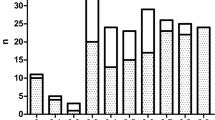Abstract
A misdiagnosis of β-thalassemia carrier in samples with Hb Tak and HbD-Punjab, the β-variants, can be a cause of inappropriate genetic counseling thus having a new case of β-thalassemia major. A capillary electrophoresis (CE) is very efficient in separating and quantifying HbA2. In this study, HbA2 levels of samples which were doubted for compound heterozygous Hb Tak/β-thalassemia or heterozygous HbD-Punjab/β-thalassemia were measured and compared between CE and high performance liquid chromatography (HPLC). The molecular confirmation for Hb Tak, HbD-Punjab and β-thalassemia codons 17 (A > T), 41/42 (-TCTT), 71/72 (+A) and IVSI-nt1 (G > T) mutations and 3.4 kb deletion were also performed. Based on DNA analysis, 3 cases were diagnosed as compound heterozygous Hb Tak/β-thalassemia and one for HbD-Punjab/β-thalassemia. The elevated HbA2 levels were found in all 4 samples with rages of 4.6–7.3% on CE while those were not found on HPLC. Thus, the elevated HbA2 measured by CE can be used as a screening parameter for differentiating the homozygote of Hb Tak and HbD-Punjab from the compound heterozygote of these hemoglobinopathies and β-thalassemia.



Similar content being viewed by others
References
Giardine B, Borg J, Viennas E et al (2014) Updates of the HbVar database of human hemoglobin variants and thalassemia mutations. Nucleic Acids Res 42:D1063–D1069
Belhoul KM, Bakir ML, Abdulrahman M (2013) Misdiagnosis of Hb D-Punjab/beta-thalassemia is a potential pitfall in hemoglobinopathy screening programs: a case report. Hemoglobin 37(2):119–123
Van Delft P, Lenters E, Bakker-Verweij M et al (2009) Evaluating five dedicated automatic devices for haemoglobinopathy diagnostics in multi-ethnic populations. Int J Lab Hematol 31(5):484–495
Keren DF, Hedstrom D, Gulbranson R et al (2008) Comparison of Sebia Capillarys capillary electrophoresis with the Primus high-pressure liquid chromatography in the evaluation of hemoglobinopathies. Am J Clin Pathol 130(5):824–831
Pornprasert S, Phusua A, Suanta S et al (2008) Detection of alpha-thalassemia-1 Southeast Asian type using real-time gap-PCR with SYBR Green1 and high resolution melting analysis. Eur J Haematol 80(6):510–514
Pornprasert S, Punyamung M, Treesuwan K (2013) Criteria for detection of alpha-thalassemia-1 Thai type deletion in routine laboratory. Clin Lab 59(11–12):1423–1427
Boonsa S, Sanchaisuriya K, Fucharoen G et al (2004) The diverse molecular basis and hematological features of Hb H and AEBart’s diseases in Northeast Thailand. Acta Haematol 111(3):149–154
Fucharoen S, Sanchaisuriya K, Fucharoen G et al (2003) Interaction of hemoglobin E and several forms of alpha-thalassemia in Cambodian families. Haematologica 88(10):1092–1098
Fucharoen S, Fucharoen G, Sanchaisuriya K et al (2000) Prenatal diagnosis of common severe thalassemia in Thailand: laboratory techniques. J Med Technol Phys Ther 12(2):53–65
Old J, Traeger-Synodinos J, Galanello R et al (2005) Prevention of thalassemias and other haemoglobin disorders. Volume 2: Laboratory methods, 1st edn. Nicosia Team up Creations, Nicosia
Sanchaisuriya K, Chunpanich S, Fucharoen G et al (2004) Multiplex allele-specific PCR assay for differential diagnosis of Hb S, Hb D-Punjab and Hb Tak. Clin Chim Acta 343(1–2):129–134
Tanphaichitr VS, Viprakasit V, Veerakul G et al (2003) Homozygous hemoglobin Tak causes symptomatic secondary polycythemia in a Thai boy. J Pediatr Hematol Oncol 25(3):261–265
Teawtrakul N, Sirijirachai C, Chansung G et al (2010) Compound heterozygous Hb Tak/Hb E causes secondary erythrocytosis in a Thai family. Hemoglobin 34(2):165–168
Fucharoen S, Changtrakun Y, Surapot S et al (2002) Molecular characterization of Hb D-Punjab [beta121(GH4)Glu → Gln] in Thailand. Hemoglobin 26:261–269
Adekile AD, Kazanetz EG, Leonova JY, Marouf R, Khmis A, Huisman TH (1996) Co-inheritance of Hb D-Punjab (codon 121; GAA → CAA) and beta (0)-thalassemia (IVS-II-1; G → A). J Pediatr Hematol Oncol 18:151–153
Taghavi Basmanj M, Karimipoor M, Amirian A et al (2011) Co-inheritance of hemoglobin D and beta-thalassemia traits in three Iranian families: clinical relevance. Arch Iran Med 14:61–63
Owaidah TM, Al-Saleh MM, Al-Hellani AM (2005) Hemoglobin D/beta-thalassemia and beta-thalassemia major in a Saudi family. Saudi Med J 26:674–677
Zakerinia M, Ayatollahi M, Rastegar M et al (2011) Hemoglobin D (Hb D Punjab/Los Angeles and Hb D Iran) and co-inheritance with α- and β-thalassemia in southern Iran. Iran Red Crescent Med J 22(7):493–498
Charoenkwan P, Thanarattanakorn P, Chaovaluksakul S (2003) Hematological and molecular characterization of beta-thalassemia/Hb Tak compound heterozygote. Southeast Asian J Trop Med Public Health 34:415–419
Das S, Mashon RS (2015) Coinheritance of Hb D-Punjab and beta-thalassemia: diagnosis and implications in prenatal diagnosis. Hemoglobin 39:138–140
Acknowledgements
The authors thank technicians at the Associated Medical Sciences Clinical Service Center, Associated Medical Sciences, Chiang Mai University, Chiang Mai, Thailand for their help and assistance. We are also grateful to Kallayanee Rock for refinement of English language.
Funding
This work was supported by grants from the University of Phayao and the National Research University Project under Thailand’s Office of the Higher Education Commission, Thailand.
Author information
Authors and Affiliations
Corresponding author
Ethics declarations
Conflict of interest
The authors report no conflicts of interest.
Ethical Standard
This study was approved by the Institutional Review Board (IRB) of the University of Phayao, Phayao, Thailand (Ethical Approval Number HE5403010001).
Informed Consent
The informed consent was obtained from the subjects included in the study.
Rights and permissions
About this article
Cite this article
Panyasai, S., Sakkhachornphop, S. & Pornprasert, S. Diagnosis of Compound Heterozygous Hb Tak/β-Thalassemia and HbD-Punjab/β-Thalassemia by HbA2 Levels on Capillary Electrophoresis. Indian J Hematol Blood Transfus 34, 110–114 (2018). https://doi.org/10.1007/s12288-017-0810-3
Received:
Accepted:
Published:
Issue Date:
DOI: https://doi.org/10.1007/s12288-017-0810-3




